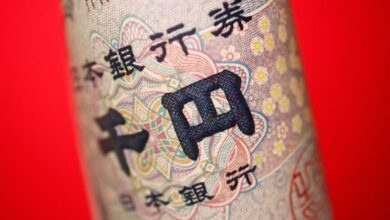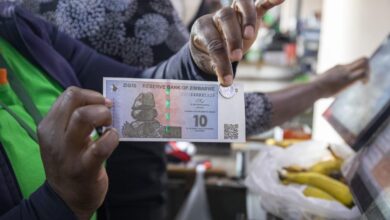Zimbabwe’s new gold-backed currency enters circulation amid high inflation-Xinhua


A man uses new currency Zimbabwe Gold banknotes to buy drink outside a bank in Harare, Zimbabwe, on April 30, 2024. (Photo by Shaun Jusa/Xinhua)
Zimbabwe’s new ZiG notes and coins began circulating on Tuesday, marking a significant step in the country’s monetary reform to curb inflation just three weeks after the electronic form of the currency started trading.
HARARE, May 1 (Xinhua) — Zimbabwe’s new ZiG notes and coins began circulating on Tuesday, marking a significant step in the country’s monetary reform to curb inflation just three weeks after the electronic form of the currency started trading.
The Reserve Bank of Zimbabwe (RBZ), the country’s central bank, introduced the new gold-backed currency, known as Zimbabwe Gold or ZiG, on April 5, replacing the inflation-ravaged Zimbabwean dollar. ZiG joins a basket of currencies accepted as legal tender in Zimbabwe, with the U.S. dollar currently dominating over 80 percent of all domestic transactions.

People queue to withdraw new currency Zimbabwe Gold outside a bank in Harare, Zimbabwe, on April 30, 2024. (Photo by Shaun Jusa/Xinhua)
In the capital, Harare, residents queued at banks to withdraw the new currency, with many expressing optimism about the change.
Mutsa Muteve, a local resident, hailed the introduction of ZiG, noting its backing by gold as a unique feature that could positively impact the economy. “If everyone has a positive attitude toward it and embraces it, I think it will make our economy better,” Muteve told Xinhua.
The physical notes and coins of ZiG come in various denominations, including 1 ZiG to 200 ZiG, as well as half ZiG and quarter ZiG. The availability of smaller denominations has brought relief to Zimbabweans, who previously had to make unnecessary purchases to round off figures to a dollar due to the unavailability of small change.

People exchange new currency Zimbabwe Gold banknotes outside a bank in Harare, Zimbabwe, on April 30, 2024. (Photo by Shaun Jusa/Xinhua)
“People are eager to have our own currency because we were using the U.S. dollar. As for transportation, some short distances cost 50 (U.S.) cents, but we were forced to pay a dollar because there were no smaller denominations. Now, with this new currency, we are now able to pay reasonable fares,” said Letwin Chimanga, another local resident.
Cash transactions were exclusively conducted in U.S. dollars as businesses rejected the inflation-ravaged Zimbabwean dollar notes, said Kunasa Musakura, a Harare resident. “The availability of ZiG now has made life easier for people to transact in different ways, so I think it’s a good thing,” he said.
ZiG, which initially traded at an exchange rate of 13.56 to the U.S. dollar on April 8, is currently exchanging at 13.43 per dollar, according to RBZ exchange rate updates. The new currency is backed by precious minerals, mainly gold, as well as foreign currency reserves, according to RBZ Governor John Mushayavanhu.
Despite the positive reception, economic analyst Prosper Chitambara cautioned that the fundamentals for a strong currency are not yet in place. “But of course, ZiG is trying to address those fundamentals, especially around unsustainable growth in money supply which then causes our inflation to remain high,” he said.
“So ZiG, by tying the reserve money supply to the reserves that we actually have, is trying to tighten the monetary policy and ensure that there is no unsustainable growth in the money supply that is actually not supported by reserves. So it should help ensure that there is a monetary discipline that is critical in terms of ensuring overall macroeconomic or price stability within the economy, because ultimately price stability is the biggest fundamental in any currency equation,” Chitambara told Xinhua.
He noted that the black market had already emerged following the introduction of the new currency.
“I am sure that’s expected given the strong demand and the strong preference for the U.S. dollar that is actually still there, but I think once we begin to see inflation actually coming down, I think that’s going to help in terms of restoration of confidence in the ZiG, and ultimately confidence in the economy,” said Chitambara.

A woman shows a new currency Zimbabwe Gold banknote outside a bank in Harare, Zimbabwe, on April 30, 2024. (Photo by Shaun Jusa/Xinhua)
Zimbabwe’s annual inflation rose to a seven-month peak of 55.3 percent in March from 47.6 percent in the previous month, according to data released by the National Statistics Agency.
Chitambara noted the emergence of a black market following the introduction of ZiG but expressed optimism that as inflation decreases, confidence in the new currency and the economy will increase.
Zimbabwe has experienced currency instability in recent years, with ZiG marking the sixth relaunch of a new currency. The country adopted a multi-currency regime in 2009 to stabilize the economy after hyperinflation.
The government briefly outlawed the use of multiple currencies in 2019, only to reintroduce the multi-currency system in 2020, with the U.S. dollar gaining prominence in transactions since then. ■





